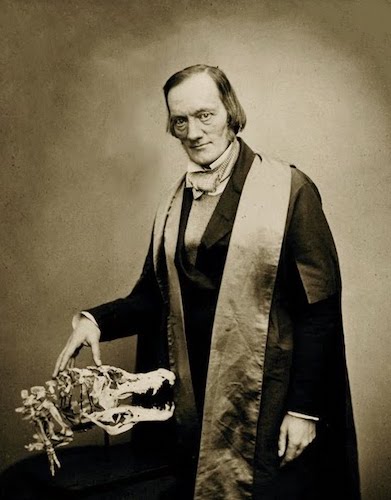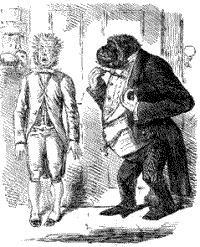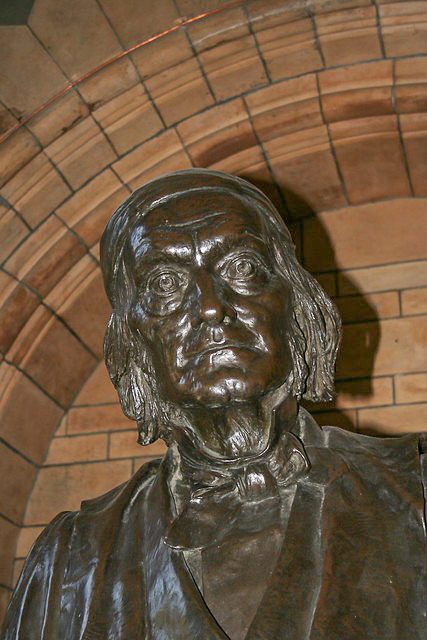
What a strange man to be envious of a naturalist like myself, immeasurably his inferior!
—Charles Darwin to J.S. Henslow, 8th May 1860
If ever an example were sought of the old dictum that history is written by the victors, we need look no further than that of the brilliant Victorian anatomist and palaeontologist Sir Richard Owen. By refusing to accept Darwin’s theory of evolution by means of Natural Selection, Owen has traditionally been portrayed as the bad boy of nineteenth-century biology. But his villainous reputation is, to some extent, undeserved.
Early Years
Richard Owen was born on 20th July 1804, in Lancaster, England. After attending the local grammar school, he became apprenticed to a local surgeon, Leonard Dickson. During his apprenticeship, Owen gained experience in post mortems at the local prison, which led to an interest in anatomy. So consuming was his interest, that he bribed a prison guard to allow him to remove the head of a recently deceased black prisoner to allow him to make inter-racial comparisons.
In 1824, Owen attended Edinburgh University medical school to study comparative anatomy. Like Darwin the following year, he enrolled in private classes in anatomy given by John Barclay, a fervent anti-materialist. Barclay later arranged for Owen to be apprenticed to another anti-materialist, John Abernathy, President of the Royal College of Surgeons.
Career
In 1827, Owen was appointed the Assistant Curator of the Royal College of Surgeons’ Hunterian Collections. So began his distinguished, 57-year museum career, the highlight of which was his appointment in 1856 as Superintendent of the Natural History Departments of the British Museum. Later, after years of lobbying by Owen, the natural history collection was relocated to Kensington, ultimately becoming the Natural History Museum.
Through his early museum work, Owen’s reputation rose rapidly. Within a few years, he was elected a Fellow of the Royal Society, and appointed Hunterian Professor then Professor of Anatomy at the Royal College of Surgeons, then Fullerian Professor of Comparative Anatomy and Physiology at the Royal Institution. His popular Hunterian Lectures were attended by the great and the good, including the young Charles Darwin, recently returned from his voyage around the world on HMS Beagle.
Owen was an astute politician, and soon came to be admired by the key figures in British natural history, which at the time was primarily an Oxbridge-based, Anglican clique. Indeed, his reputation spread to such an extent that Prince Albert eventually asked him to tutor the royal children. The prince also suggested Owen be put in charge of designing the dinosaur exhibits for the Great Exhibition of 1851.
Man of Science
During his career, Owen published scores of major scientific papers. He established his reputation as a great anatomist with his Memoir on the Pearly Nautilus (1832). His two-volume comparative analysis of animals’ teeth, Odontography (1840–45), is still regarded as a classic in its field.
In 1839, Owen famously deduced the existence of an extinct giant moa, Dinoris, from a single fragment of bone (although he was later accused of failing to acknowledge that others had already come to the same conclusion). Then, in 1842, in an article in the Proceedings of the British Association for the Advancement of Science, Owen established the order Dinosauria. His dinosaur classifications were built on extensive groundwork by others, especially Gideon Mantell, although this went mostly unacknowledged by Owen. By naming the dinosaurs, Owen cleverly appropriated the popular ‘terrible lizards’ as his own. His actions initiated a bitter rivalry with Mantell
Owen’s other notable works include: Lectures on Comparative Anatomy and Physiology of the Vertebrate Animals (1846); A History of British Fossil Mammals and Birds (1846); On the Nature of Limbs (1849); A History of British Fossil Reptiles (1849–84); and On the Anatomy of Vertebrates (1866–68).
The British Cuvier
Owen’s work in comparative anatomy was so highly regarded that the geologist Rev. William Buckland dubbed him ‘the British Cuvier’. Owen and Cuvier had paid each other reciprocal visits in 1830, and, the following year, Owen attended the last of the famous debates between Cuvier and his great rival, Geoffroy Saint-Hilaire.
The Cuvier comparison not entirely welcomed by Owen. His ambition was to outshine the great French star of anatomy, and, by the late 1840s, his work was no longer Cuverian in approach (see below). “I wish they would be content to let me be the Owen of England,” he is said to have remarked.
Archetypes
It has been said that Owen did not accept that species evolve. Indeed, in the first edition of On the Origin of Species, Darwin described Owen as “being firmly convinced of the immutability of species”. In later editions of the work, Darwin described this misunderstanding as “a preposterous error”—although he qualified his retraction by (quite reasonably) pointing out that Owen’s writings on the subject were “difficult to understand and to reconcile with each other”.
In his early career, Owen certainly did not believe in the transmutation of species: he was a Cuverian functionalist through-and-through, believing that each species had been uniquely designed and created by God, perfectly adapted for its lifestyle. Such a philosophy was almost essential in terms of gaining the support of the mainly Anglican scientific establishment.
By the mid–1840s, however, Owen’s views had changed, primarily as a result of his work on the comparative anatomy of vertebrates. He believed that all vertebrates were based on the same basic (divine) blueprint, or archetype. All species were built upon this archetype, each one being a unique extension of it; an extension which came about through various vaguely defined ‘secondary laws’ (for which, read one or more forms of divinely influenced evolution). In devising this explanation of vertebrate anatomy, Owen effectively merged the opposing viewpoints of Cuvier and Geoffroy Saint-Hilaire.

Whereas Owen saw his archetype as, in effect, a lowest common denominator of vertebrates, Darwin later saw it simply as the common ancestor.
Baited by the Bulldog
As we have seen, although Owen was no Darwinian, he did believe in a form of evolution. So why has he traditionally been seen as an anti-evolutionist?
The answer would seem to be down to his long-standing feud with Darwin’s most outspoken ally (and ‘Bulldog’), Thomas Henry Huxley. Throughout his distinguished career, despite having being helped early in that career by Owen, Huxley never missed an opportunity to savage Owen’s reputation. Different reasons have been put forward for the rivalry. Some have suggested that, after initial friendliness towards Huxley, Owen began to feel threatened by the brilliant younger man. Others believe that, in order to advance his career, Huxley felt he needed to slay a giant in the same field. The relationship certainly wasn’t helped by Owen’s delivering lectures in Huxley’s own stronghold, the London School of Mines, describing himself as the local professor—for which Huxley demanded, and obtained, a retraction.
Whatever its causes, the Owen-Huxley rivalry led to one of the most famous battles in Victorian science:
Gorilla Warfare
Ever since his early Hunterian career, Owen had studied the comparative anatomy of apes and humans. Everywhere he looked, he saw the need to emphasise their differences. In 1844, he wrote:
The Chimpanzee being the highest organized quadrumanous animal and the first in the descensive scale, from Man, every difference between its anatomy and the Human exemplifies in the most instructive manner the characteristic peculiarities of the human organisation.
By 1857, however, he had begun to acknowledge the similarities between humans and apes:
I cannot shut my eyes to the significance of that all-pervading similitude of structure—every tooth, every bone, strictly homologous,—which makes the determination of the difference between Homo [humans] and Pithecus [orang-utans] the anatomist’s difficulty.
To keep mankind’s special place in nature, Owen decided he needed to concentrate on the feature universally acknowledged as most definitive of humans: their unique brains. Thus began his great battle with Huxley over the similarity (or otherwise) of the brains of humans and apes. This battle took place during the three years immediately following the publication of On the Origin of Species, 1860–1862.
The battle was characterised by the two great anatomists’ repeatedly making subtly different comparisons between the brains of humans and members of the order Quadrumana [apes, monkeys, lemurs, etc.]. The very fact Huxley’s and Owen’s comparisons were subtly different, however, meant they were not engaging in a meaningful argument. Putting their two arguments simply, Huxley maintained there was far less difference between the brain of humans and the “highest” of the Quadrumana (at the time, believed to be the recently discovered gorilla), than between the “highest” of the Quadrumana and the “lowest” (the lemur); Owen, on the other hand, contended that there was far more difference between the brains of humans and the “highest” of the Quadrumana, than between the “highest” of the Quadrumana and the next “highest”. These two claims are not necessarily in disagreement—but that’s not how the British public (or the contestants) appear to have seen it.
The high-point of the battle for Huxley came when he conclusively demonstrated that the hippocampus minor, a small fold at the back of the brain, which Owen said was unique to humans, was also to be found in the brains of apes.

Punch, 25 May 1861
The British public relished the unseemly battle, which was celebrated in prose, play, cartoon and verse, even being parodied in Charles Kingsley’s Water Babies (1863):
No, my dear little man; always remember that the one, true, certain, final and all-important difference between you and an ape is, that you have a hippopotamus major in your brain, and it has none; and that to discover one in its brain will be a very wrong and dangerous thing, at which every one will be very much shocked.
Whatever the true merits of the debate, in the eyes of the public, Huxley was ultimately perceived to have been the winner.
Subterfuge
Owen’s ongoing battles with Huxley may well have caused him to appear more anti-evolutionary than he actually was. But Owen’s cautiously concealed, evolutionary (albeit non-Darwinian) beliefs made him reluctant to speak out openly against Darwin’s On the Origin of Species when it was published in November 1859—despite considerable prompting from the Oxbridge elite. Instead, he resorted to subterfuge, writing an anonymous article in the Edinburgh Review in April 1860. In fairness to Owen, all Edinburgh Review articles were published anonymously, but he certainly made the most of his anonymity. In the article, Owen criticised Darwin’s reasoning, and heaped praise (in the third person) upon his own work, while being careful not to associate any particular mechanism for evolution with his own name.
Darwin and his allies knew immediately who had written the article, and took great umbrage at the way in which it misrepresented his work.
A Spent Force?

The traditional view that Darwin and his allies won the dayand that, following the publication of On the Origin of Species, and subsequent defeats by Huxley, Owen became a bitter, spent force, is simplistic in the extreme. Owen may well have lost the occasional battle, but he did not concede the war—if, indeed, there ever was a war.
Owen was not a particularly pleasant man. He was an extremely astute political figure, who did not take criticism well, who seldom acknowledged his own mistakes, and who did not always give credit where credit was due. But he was also, undoubtedly, one of the greatest scientific figures of Victorian England. He continued his brilliant career until his official retirement at the age of 79. Even then, he continued his work, corresponding with William Gladstone and others, and observing the birds in his garden. He accepted his (previously declined) knighthood in 1844, and went on to outlive his old rival, Darwin, by ten years, dying of ‘old age’ on 18th December 1892.
Owen’s statue sits a short distance from that of Darwin in what is perhaps the greatest memorial to his achievement, the Natural History Museum, Kensington, London.

Leave a Reply to Suzette Cancel reply